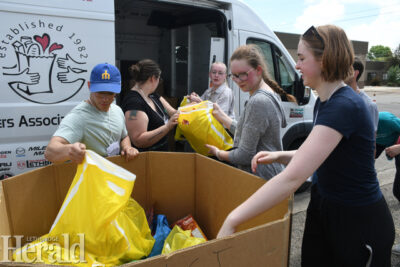Food banks doing what they can, but help is needed
By Steffanie Costigan - Lethbridge Herald Local Journalism Initiative Reporter on October 7, 2023.
 Herald file photo
Volunteers unload a van of food donations during this year's Target Hunger initiative. Food banks doing what they can, but help is needed says Interfaith Food Bank executive director Danielle McIntyre.
Herald file photo
Volunteers unload a van of food donations during this year's Target Hunger initiative. Food banks doing what they can, but help is needed says Interfaith Food Bank executive director Danielle McIntyre.Food banks across Alberta have seen a 73-per-cent increase between 2019 to 2022, and the Interfaith Food Bank has had to adapt to the growing food security crisis to help families put food on the table.
Danielle McIntyre, executive director of Interfaith Food Bank, says the food bank is doing what it can to address food insecurity, but it needs the help of the community.
“We know it’s a rising concern, and the work that we do at Interfaith Food Bank is a way that people can help with the issue,” McIntyre said Thursday during a session of the Southern Alberta Council on Public Affairs. “It will not solve the issue, but it will help the issue.”
McIntyre said 2.8 million Canadians are currently living in poverty with even more Canadians experiencing food insecurity, which is the state of having reliable access to a sufficient quantity of affordable and nutritious food.
“It’s not just about having enough food, it’s about being able to get to it, being able to get enough of it and being able to make sure that we can afford good food, not just any food.”
McIntyre shared a statistical report, along with data, that shows one in five Albertans were food insecure in 2022. The numbers have increased since then, however, and last year one in four Albertans, 25 per cent, experienced food insecurity.
“We put out their poverty report card. And unfortunately, almost every province received a failing grade due to inadequate responses at all levels of government to the rising insecurity that we’re seeing across the country.”
McIntyre noted one in three Albertans are experiencing mental health challenges which prohibits them from earning a stable income, along with 56 per cent of Albertans struggling with addictions in communities.
“Not everybody reports when they don’t have enough to eat. And not everybody actually goes to a food bank or an agency to get help, many suffer in silence.”
McIntyre added Albertans have “the worst ratings for social assistance support,” and Alberta has the highest per cent of people working but unable to earn enough for food.
“We also have the highest percentage of working people that still can’t afford to buy their groceries. That’s income inequality. It’s due to having low paying jobs, or part time jobs with not enough hours to earn enough income to cover your food.”
McIntyre said everyone in the community, including herself, is feeling the impact of the rising cost of living, with 35 per cent of income going to housing, 56 per cent to internet, transportation, and groceries. She said Albertans could not afford an unexpected cost of $500.
“The bigger issue is that people who are in poverty are staying in poverty. And a lot of that is generational.”
McIntyre stressed the need for more volunteers at the Interfaith Food Bank and invited residents to visit and see how it operates and help them better understand the important service it provides.
“I also invite you to come down for a tour. Give us a call-in advance we’ll walk you through the operation. You’ll have the opportunity to see every program that we’ve got; all the resources that you can be engaged with in the community.”
16-15


